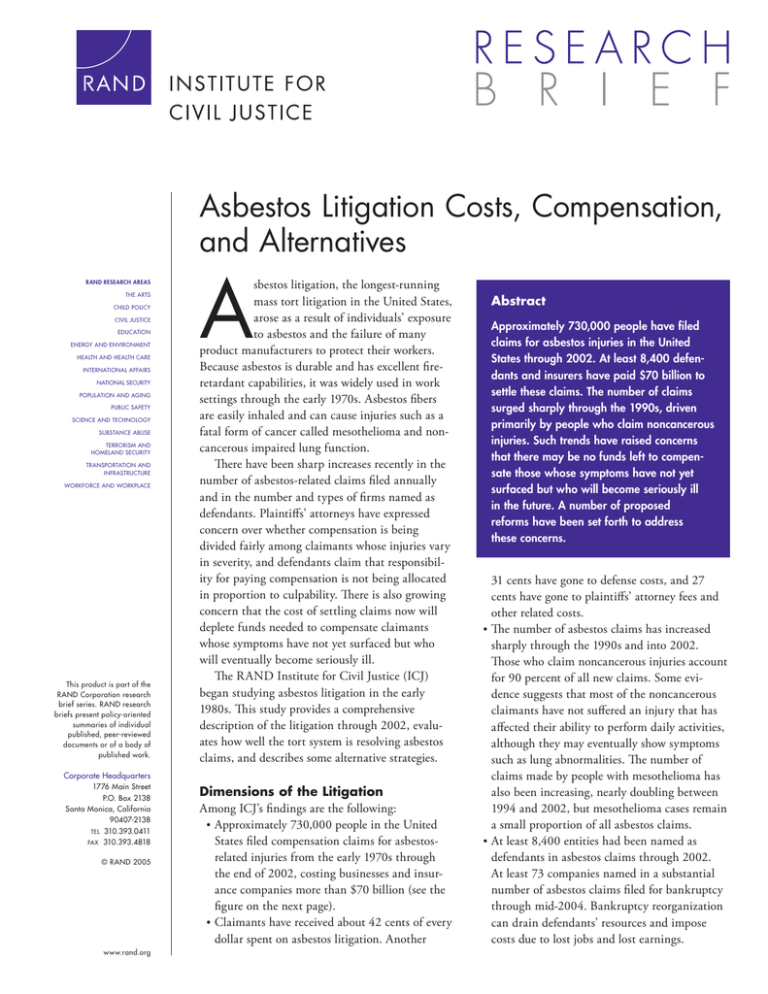A Asbestos Litigation Costs, Compensation, and Alternatives
advertisement

Asbestos Litigation Costs, Compensation, and Alternatives RAND RESEARCH AREAS THE ARTS CHILD POLICY CIVIL JUSTICE EDUCATION ENERGY AND ENVIRONMENT HEALTH AND HEALTH CARE INTERNATIONAL AFFAIRS NATIONAL SECURITY POPULATION AND AGING PUBLIC SAFETY SCIENCE AND TECHNOLOGY SUBSTANCE ABUSE TERRORISM AND HOMELAND SECURITY TRANSPORTATION AND INFRASTRUCTURE WORKFORCE AND WORKPLACE This product is part of the RAND Corporation research brief series. RAND research briefs present policy-oriented summaries of individual published, peer-reviewed documents or of a body of published work. A sbestos litigation, the longest-running mass tort litigation in the United States, arose as a result of individuals’ exposure to asbestos and the failure of many product manufacturers to protect their workers. Because asbestos is durable and has excellent fireretardant capabilities, it was widely used in work settings through the early 1970s. Asbestos fibers are easily inhaled and can cause injuries such as a fatal form of cancer called mesothelioma and noncancerous impaired lung function. There have been sharp increases recently in the number of asbestos-related claims filed annually and in the number and types of firms named as defendants. Plaintiffs’ attorneys have expressed concern over whether compensation is being divided fairly among claimants whose injuries vary in severity, and defendants claim that responsibility for paying compensation is not being allocated in proportion to culpability. There is also growing concern that the cost of settling claims now will deplete funds needed to compensate claimants whose symptoms have not yet surfaced but who will eventually become seriously ill. The RAND Institute for Civil Justice (ICJ) began studying asbestos litigation in the early 1980s. This study provides a comprehensive description of the litigation through 2002, evaluates how well the tort system is resolving asbestos claims, and describes some alternative strategies. Corporate Headquarters 1776 Main Street P.O. Box 2138 Santa Monica, California 90407-2138 TEL 310.393.0411 FAX 310.393.4818 © RAND 2005 www.rand.org Dimensions of the Litigation Among ICJ’s findings are the following: • Approximately 730,000 people in the United States filed compensation claims for asbestosrelated injuries from the early 1970s through the end of 2002, costing businesses and insurance companies more than $70 billion (see the figure on the next page). • Claimants have received about 42 cents of every dollar spent on asbestos litigation. Another Abstract Approximately 730,000 people have filed claims for asbestos injuries in the United States through 2002. At least 8,400 defendants and insurers have paid $70 billion to settle these claims. The number of claims surged sharply through the 1990s, driven primarily by people who claim noncancerous injuries. Such trends have raised concerns that there may be no funds left to compensate those whose symptoms have not yet surfaced but who will become seriously ill in the future. A number of proposed reforms have been set forth to address these concerns. 31 cents have gone to defense costs, and 27 cents have gone to plaintiffs’ attorney fees and other related costs. • The number of asbestos claims has increased sharply through the 1990s and into 2002. Those who claim noncancerous injuries account for 90 percent of all new claims. Some evidence suggests that most of the noncancerous claimants have not suffered an injury that has affected their ability to perform daily activities, although they may eventually show symptoms such as lung abnormalities. The number of claims made by people with mesothelioma has also been increasing, nearly doubling between 1994 and 2002, but mesothelioma cases remain a small proportion of all asbestos claims. • At least 8,400 entities had been named as defendants in asbestos claims through 2002. At least 73 companies named in a substantial number of asbestos claims filed for bankruptcy through mid-2004. Bankruptcy reorganization can drain defendants’ resources and impose costs due to lost jobs and lost earnings. • An increasing share of claims since the 1990s is being brought by workers exposed to asbestos in industries such as the textile, paper, glass, and food industries, where workers did not routinely handle asbestos, but asbestos was present in the workplace. Most claims had been from workers in asbestos mining and manufacturing. The litigation is concentrated in eight industries, but at least one defendant company can be found in 75 of the 83 industries at the two-digit level in the U.S. Department of Commerce Standard Industrial Classification system. Components of Asbestos Litigation Cost and Compensation, Spending Through 2002 Total spending ($70 billion) Defense transaction costs ($21 billion) (31% of total spending) Claimants’ transaction costs ($19 billion) (27% of total spending) Gross compensation ($49 billion) (69% of total spending) Net compensation ($30 billion) (42% of total spending) How Well Is the Tort System Working in Handling Asbestos Claims? The tort system in the United States has three objectives: compensation, deterrence, and individualized corrective justice. The commitment of tort law to “make victims whole,” deter injurious behavior, and provide individuals with their “day in court,” and its adaptability to change, are generally seen as justification for the tort system’s transaction costs, which are higher than the costs associated with delivering benefits through administrative systems such as workers’ compensation. Compensation. Mass litigation strategies have opened the courts to anyone who can prove exposure to asbestos, even if the claims are minor, thus providing increased access to the courts. However, expanded access may jeopardize the ability of the tort system to compensate future claimants, some of whom will have fatal injuries. There is no research that compares the total compensation received by plaintiffs with the plaintiffs’ economic loss. It is clear, however, that the personal injury trusts established as part of asbestos defendants’ bankruptcy proceedings pay only a fraction of the agreed-upon value of plaintiffs’ claims. Deterrence. As litigation spreads to companies outside of the asbestos and building-products industries, the culpability of defendants is more in dispute. If business leaders believe that tort outcomes have little to do with their own behavior, then there is no reason for them to alter their behavior to minimize tort exposure, and the deterrence objective of the tort system is undercut. Individualized Treatment. In asbestos litigation, individualized justice is a myth. Most cases are settled with a flat fee negotiated by attorneys. Many cases that go to trial are grouped with as many as 100 other cases, and compensation is similar for all. Consolidated trials are not unique to asbestos litigation, but they are more prevalent, of a larger scale, and more complex. Is There a Better Way? Many proposals have been set forth as better alternatives than the tort system for resolving asbestos claims. The goals of these reforms are to provide fairer allocation of compensation dollars and more equitable responsibility for payments, and to achieve both ends quickly and at a lower cost. Since the beginning of asbestos litigation in the 1970s, at least 15 reform bills have been introduced in the U.S. Congress, but none has garnered enough support to become law. Those reform bills have typically been of two types. One type would allow claims to remain in the legal system, but limit compensation to only those people whose injuries meet certain medical criteria. Such a system would require the fewest changes, but it would prevent many asbestos-exposed workers—those who are not functionally impaired and do not have asbestos-related cancer—from seeking compensation. Another type would eliminate tort liability and create an administrative compensation system funded by defendant corporations and insurers. This trust fund would make payments to injured workers who meet certain criteria. But such a proposal must address difficult issues such as how much will be needed to pay future claims and how much each contributor should pay. The states may play a larger role in settling asbestos claims. Some states have introduced statutes limiting compensation to those who meet certain medical criteria. Others have invited consolidation of cases. But such efforts are likely to create a patchwork of tort doctrine and mass litigation procedural rules that promises continuing variation in asbestos outcomes that would do little to mitigate the high transaction costs of asbestos litigation. Finally, the personal injury trusts that usually result from bankruptcy proceedings may resolve claims quickly and with lower costs. But the trusts may be unfair to some classes of asbestos plaintiffs and may lead to lengthy appellate processes and ancillary litigation. In 2005, Congress was again debating the details of a bill to establish a universal trust fund for asbestos victims. As of this writing, the fate of the bill is still uncertain. This research brief describes work done for the RAND Institute for Civil Justice and documented in Asbestos Litigation by Stephen J. Carroll, Deborah Hensler, Jennifer Gross, Elizabeth M. Sloss, Matthias Schonlau, Allan Abrahamse, and J. Scott Ashwood, MG-162-ICJ, 2005, 206 pages, $20, ISBN: 0-8330-3078-7. MG-162-ICJ is available online at http://www.rand. org/publications/MG/MG162/. Copies of this research brief and the complete report on which it is based also are available from RAND Distribution Services (phone: 310-451-7002; toll free: 877-584-8642; or email: order@rand.org). The RAND Corporation is a nonprofit research organization providing objective analysis and effective solutions that address the challenges facing the public and private sectors around the world. RAND’s publications do not necessarily reflect the opinions of its research clients and sponsors. R® is a registered trademark. RAND Offices Santa Monica RB-9155-ICJ (2005) • Washington • Pittsburgh • Doha • Berlin • Cambridge • Leiden THE ARTS CHILD POLICY This PDF document was made available from www.rand.org as a public service of the RAND Corporation. CIVIL JUSTICE EDUCATION ENERGY AND ENVIRONMENT HEALTH AND HEALTH CARE INTERNATIONAL AFFAIRS NATIONAL SECURITY This product is part of the RAND Corporation research brief series. RAND research briefs present policy-oriented summaries of individual published, peerreviewed documents or of a body of published work. POPULATION AND AGING PUBLIC SAFETY SCIENCE AND TECHNOLOGY SUBSTANCE ABUSE TERRORISM AND HOMELAND SECURITY TRANSPORTATION AND INFRASTRUCTURE The RAND Corporation is a nonprofit research organization providing objective analysis and effective solutions that address the challenges facing the public and private sectors around the world. WORKFORCE AND WORKPLACE Support RAND Browse Books & Publications Make a charitable contribution For More Information Visit RAND at www.rand.org Explore RAND Institute for Civil Justice View document details Limited Electronic Distribution Rights This document and trademark(s) contained herein are protected by law as indicated in a notice appearing later in this work. This electronic representation of RAND intellectual property is provided for noncommercial use only. Permission is required from RAND to reproduce, or reuse in another form, any of our research documents for commercial use.





